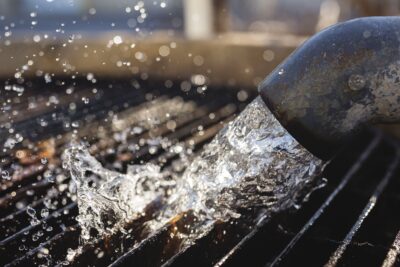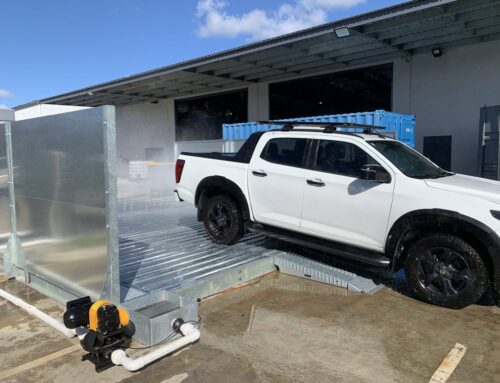Industrial operations across Australia are increasingly held to account for their environmental impact—especially when it comes to wash water or wastewater discharge. If your workshop handles vehicle wash activities, heavy machinery or equipment cleaning, or wastewater generation, you may be closer to non-compliance than you realise.
Frustrated with the case of suppliers who don’t understand your needs? Many operations managers find that generic wash solutions can’t meet the strict requirements of Australian regulators. That’s where tailored, compliant wash bay systems become essential—not only to ensure legal compliance but to improve efficiency and reduce operational costs. Contact EnviroConcepts today for tailored portable wash bays and water recycling systems.
This article will help you understand how to avoid environmental breaches, wastewater recycling, reduce water use, stay compliant with local authority requirements, and choose a wash bay system that fits your industry or workshop.
Top Environmental Compliance Risks in Industrial Wash Bays

Wash water generated during industrial cleaning contains a mix of oil, grease, sediment, metals, and chemicals. Without proper containment and recycling, it can pollute local environments and trigger the case of significant penalties.
The most common compliance risks include:
- Wash bay floor systems without proper bunding or waterproofing solutions
- Lack of equipment such as oil water separators and basic silt traps
- Inadequate pre treatment of wash water before sewer discharge
- Unroofed wash bays that allow stormwater ingress and cross-contamination
- Failure to use holding tanks to manage flow rates and retention
- Discharging without a trade waste permit from the relevant local authority
These issues are often the result of poor wash bay design and construction or off-the-shelf solutions that do not match the specific needs of the operation.
How Wash Bays Stop Water Pollution and Meet Regulations
Wash bays are not simply vehicle and equipment cleaning zones—they are engineered containment, treatment, and recycling systems. The purpose of a compliant wash bay is to capture, treat, and manage wastewater to prevent environmental contamination and meet trade waste discharge standards.
A well-designed wash bay integrates:
- Controlled wash bay floor with bunding and appropriate slope
- Flush diversion system to redirect first flush rainwater
- Silt traps to intercept large solids
- Oil water separators to remove hydrocarbons and grease
- Holding tanks to regulate flow and prevent overload
- Water recycling and water treatment systems that process and recycle water on-site
By separating pollutants at multiple stages, these systems significantly reduce environmental risk while supporting cleaner workshop operations.
Key Compliance Features Your Wash Bay Must Include
When it comes to the case of compliance, it is not just about installing a portable wash bay and hoping for the best. Your system should be purpose-built to prevent illegal discharges and meet regional requirements. Whether you run a workshop, a car wash, a construction site, a transport depot, or a mining facility, the following features are critical:
- Wash bay floor must be impermeable and include bunding to contain spills
- Oil water separators must be sized appropriately for the volume and type of waste
- Silt traps must capture solids and grit before the water enters treatment
- Flush diversion system must be in place for unroofed wash bays
- Pre treatment must address pH levels, temperature, and suspended solids
- Holding tanks must ensure retention time to allow for proper separation and treatment
Each of these components plays a role in ensuring that your wash water does not contaminate surrounding areas or exceed the limits set by local authorities.
Wash Water Discharge Rules Explained: Permits, Limits & Compliance

In Australia, discharging wash water into the sewer system or natural waterways is tightly controlled. Operators must apply for and adhere to a trade waste permit issued by their local council or water authority.
Typical discharge limits include:
- Oil and grease: less than 100 mg/L
- Suspended solids: less than 600 mg/L
- pH range: typically between 6.0 and 10.0
Exceeding these limits can result in the case of penalties, site inspections, or even operational shutdowns. Additionally, AQIS regulations may apply to transport and agricultural sites handling biohazards or organic contaminants.
Trade waste compliance starts with the right system design. Pre treatment units, oil water separators, and flow control equipment must be chosen based on the pollutants and volumes specific to your application or workshop.
How Eco-Compliant Wash Bays Save You Money and Protect the Planet
There is a common misconception that compliance costs more than it saves. That’s not the case. In reality, installing the right wash bay system can significantly reduce your operating costs over time. Here’s how:
- Water recycling systems reuse up to 80% of wash water, reducing consumption and utility charges
- Portable wash bay solutions reduce civil works and enable rapid redeployment to different sites
- Flush diversion and holding tanks lower your risk of non-compliance fines
- Proper treatment ensures you avoid environmental damage and associated cleanup costs
When sustainability is embedded into the design of modular and portable wash bays, the result is a more resilient, cost-effective operation. And with water scarcity a growing concern in parts of Australia, responsible usage is not just encouraged—it is expected.
The Real Cost of Non-Compliance: Fines, Liability, and Brand Damage
Non-compliance with wastewater regulations can result in significant consequences. Across Australia, fines for illegal discharges routinely exceed $100,000. In some cases, penalties have included criminal charges, public notice requirements, and civil liability for environmental remediation.
Beyond financial penalties, there are also:
- Costs associated with site downtime during investigations
- Legal fees for defending against enforcement action
- Long-term brand damage, especially in sensitive industrial regions
- Increased scrutiny from regulators on future permits or expansions
In the case of companies operating near local residents or in areas of ecological sensitivity, the impact of a single discharge event can extend well beyond the site boundary.
How to Choose the Right Wash Bay for Your Industry and Pollutants
Selecting the right wash bay system depends on understanding the types of pollutants your operation produces and the constraints of your site or workshop. For instance:
- A mining operation may need heavy-duty filtration and high-capacity holding tanks
- An equipment hire yard may require a relocatable, modular wash bay for different vehicle types
- A car wash may need efficient sediment and oil removal with water recycling
- A transport depot may need to meet AQIS standards and handle heavy axle loads
- A construction site may need a rugged, portable wash bay to manage mud, concrete runoff, and sediment on uneven terrain
In all cases, the wash bay design and construction must be tailored. This includes selecting the correct equipment like oil water separators, configuring flush diversion for unroofed areas, and ensuring that water treatment systems meet both current and projected needs. Contact EnviroConcepts to find the perfect fit for your needs.
3-Step Process to Get Compliant Fast
- Site Assessment
Contact our team at EnviroConcepts. We begin with an inspection of your workshop or site and a consultation to determine operational needs, volume estimates, and pollutant types. - Custom System Design
Get a detailed proposal with specifications, costs, and a timeline based on your exact requirements. - Installation and Support
Receive professional installation, system commissioning, and ongoing support with Australian-based service teams.
This process ensures you receive compliant, cost-effective wash bays without the delays and uncertainties of offshore manufacturing.
Maintenance That Matters: Keeping Your Wash Bay Compliant for Years
Compliance doesn’t end after installation. Maintenance is essential for continued performance of your wash bays. Regular servicing should include:
- Inspection and cleaning of oil water separators and silt traps
- Monitoring of pH levels and sediment buildup in treatment systems
- Routine checks on pumps, bunds, and holding tanks
- Inspection of the wash bay floor for wear, cracks, or leaks
- Documentation of all maintenance for council audits
Wash bays with proper service intervals not only stay compliant longer but also require fewer emergency repairs or replacements. Support contracts can further reduce the administrative burden for operations managers.
Wash Bay Filtration Systems: Removing Oils, Sediments, and Heavy Metals
Filtration is at the heart of any compliant wastewater or wash water treatment system. The goal is to reduce pollutants to legal discharge levels using multiple stages of removal:
- Silt traps and screens handle large debris and suspended solids
- Oil water separators remove floating oils and light hydrocarbons
- Pre treatment systems may include pH adjustment, flocculation, or UV disinfection
- Additional filtration stages may target heavy metals or fine particulates
Depending on your pollutants and flow rate, the filtration system must be scalable. It should also be accessible for servicing and modular or portable in design to allow upgrades as environmental standards evolve.
Sustainable Wash Bay Operations: Best Practices to Follow
To operate sustainably, your business or workshop should move beyond compliance and adopt operational best practices:
- Use water recycling systems to lower total consumption
- Conduct regular staff training on equipment use and spill response
- Implement checklists for equipment start-up, shutdown, and cleaning
- Install signage and operational guidelines near wash areas
- Select quality product components designed for Australian conditions
Unroofed wash bays should include rainwater management protocols to avoid stormwater cross-contamination. Where possible, systems should be designed to accommodate future expansion or integration with broader site water treatment efforts.
Future-Proof Your Operations: Why the Right Wash Bay Is Your Best Compliance Strategy
You need custom solutions, not one-size-fits-all systems. From the construction of portable wash bay setups to complex water treatment systems, ensuring compliance is no longer a luxury—it is a necessity. Choosing the right system will protect your site from environmental breaches, reduce long-term costs, and align your operation with sustainable industry standards.
If you’re unsure whether your current system is compliant, or if you’re planning an upgrade, contact EnviroConcepts today for a consultation. We offer nationwide support, fast turnaround, and Australian-made portable wash bay systems built for performance, compliance, and durability.




